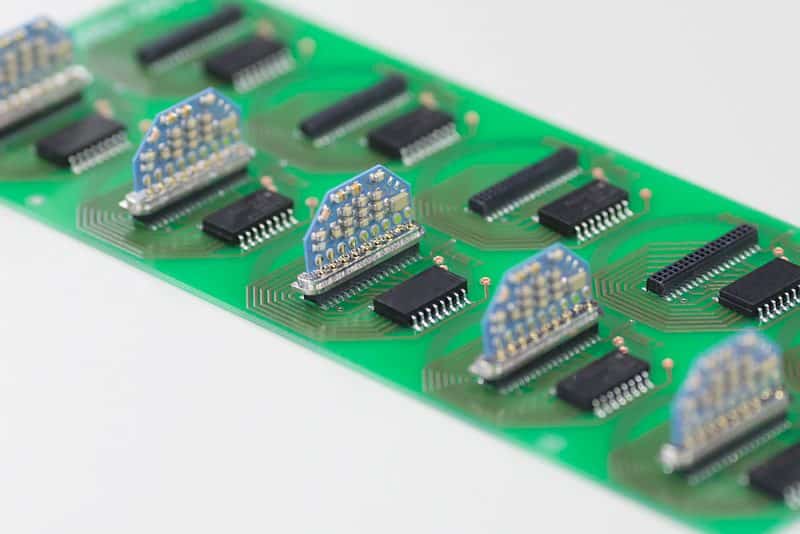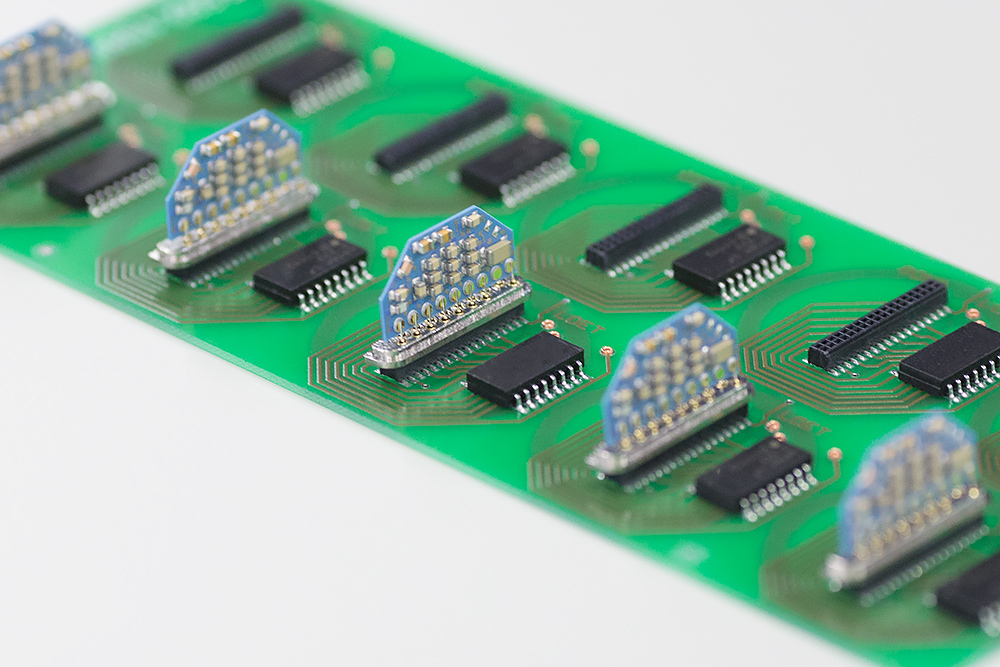MED-EL
Published Feb 14, 2018
Independent Safety Capacitors: Delivering Superior Reliability

Earlier, we looked at how MED-EL openly shares comprehensive reporting on the reliability of our cochlear implants. For more than 20 years, we’ve been proud to provide our recipients with the peace of mind that comes with exceptionally reliable implants.
So, how does MED-EL make such reliable cochlear implants? Every MED-EL implant is precisely crafted by experts at our headquarters in Innsbruck, Austria. But, our superior reliability doesn’t just come from the outstanding quality of our manufacturing. When it comes to making the most reliable cochlear implants, it’s what’s on the inside that counts.
Today, we’re looking at one of the most important safety & reliability mechanisms in MED-EL cochlear implants—independent safety capacitors. What are safety capacitors? Essentially, they’re a safeguard that ensures the implant stimulation is always precisely controlled.
In fact, they’re so important, we dedicate almost half the space inside our cochlear implants to safety capacitors. There’s 14 capacitors total; one for each independent electrode channel, plus two more for the reference electrodes.
So, how do safety capacitors work, and why are they so essential for long-term reliability & safety? Keep reading—in just a few minutes, you’ll be an expert on safety capacitors.
Cochlear Implant Stimulation
Let’s start with the basics. Cochlear implants work by sending electrical pulses to electrode contacts on an electrode array in the cochlea. These electrical pulses activate nerve structures in the cochlea and trigger a response in the auditory nerve. The auditory nerve carries this information to the brain, where the nerve signals are perceived as sound. Simple, right?
Let’s take a closer look at where technology meets biology. At the electrode contact in the cochlea, electrical energy is transferred to the cochlea’s neural structures in a very specific way. By moving electrical current back and forth, the stimulation momentarily changes the natural energy balance of cells surrounding the electrode contact.
This energy change activates a response in the surrounding nerve cells. This signal is rapidly transmitted as a nerve signal through the auditory nerve—turning electrical energy into a nerve signal the brain can understand.
However, it’s important to restore the natural balance of the cochlea—this balance is very finely tuned. If you don’t immediately reverse the change in electrical charge, you can actually damage the surrounding nerve cells. This can happen when stimulation is not balanced—momentary changes can become permanent.1,2
Alternating Current: Safe Stimulation
That’s why cochlear implants use “biphasic pulses”. A few nanoseconds after the negative “pull”, an equal-but-opposite positive charge phase is used to reverse the ionic change. This pull-push is essential for balancing out the changes.
Balanced biphasic AC cochlear implant stimulation pulse. The negative charge is balanced out by the positive charge, resulting in safely balanced stimulation with no net change over time.
This back-and-forth flow of current is known as alternating current (AC). With balanced AC, you can safely stimulate the cochlea for many, many years. That’s why it’s essential for cochlear implants to only use alternating current, and to avoid any direct current (DC) flow.1,2
Direct Current: Harmful Current Leakage
If you just pushed electrical charge into the cochlea, you would quickly create a chemical imbalance. When the energy only travels in one direction, this is known as direct current (DC). Direct current is not reversed by an opposite charge, so it can quickly cause an ionic imbalance. This would unfortunately alter the pH of the intracochlear fluid around the electrode contacts, making it more basic or acidic.1,2
Direct current is not an intentional part of cochlear implant stimulation. It’s a side effect that occurs when the biphasic AC stimulation pulses are not precisely controlled. For example, if a stimulation pulse pulls 10 electrons and then reverses the charge by pushing 11 electrons—you have an extra electron flowing in only one direction. This charge imbalance is often referred to as “leakage current”.1,2
Why is direct current such a problem? Studies have shown that charge imbalance from direct current may cause serious issues, including:
- Damage to neural tissue1,2
- Dissolution (dissolving) of platinum electrode contacts3
Clearly, direct current needs to be avoided with cochlear implants. So how can it be prevented?
Safety Capacitors: Long-Term Safety
Good news: Direct current flow is essentially impossible with all MED-EL cochlear implants. The circuitry of our implants is designed to completely block DC flow at each individual electrode with special filters known as “safety capacitors”.
How does a safety capacitor work? Basically, a capacitor works like a high-tech gatekeeper. Safely balanced alternating current can flow back and forth through a capacitor, but harmful DC current is blocked. This allows incredibly precise flow of current—enabling many, many years of safe stimulation.4,5
MED-EL uses independent safety capacitors on every single electrode channel, plus two extra for the reference electrodes. This makes 14 safety capacitors in total. If this sounds like a lot of safety capacitors, you’re right—they take up almost half the circuit board inside our implants.
 The “brains” of MED-EL cochlear implants: Ti100 chips being tested for reliability, with 14 safety capacitors visible on each blue implant circuit board. The capacitors are the silver/beige rectangles that cover most of the chip.
The “brains” of MED-EL cochlear implants: Ti100 chips being tested for reliability, with 14 safety capacitors visible on each blue implant circuit board. The capacitors are the silver/beige rectangles that cover most of the chip.
Precision Engineering
Why are independent safety capacitors so important, and why did we commit so much of our hardware to safety?
With independent safety capacitors protecting every channel, our implants can safely run much faster & longer stimulation, and deliver more advanced sound coding. Safety capacitors are like a very precise controller constantly managing each individual electrode channel.4
Every MED-EL electrode channel on the array can run independently or even work together to create intermediate pitch percepts between two electrode contacts. It’s like being able to play a 250-key piano with 12 fingers precisely working together at once.
That’s why we’re able to offer so many exclusive sound coding technologies that other implants can’t match, including triphasic pulses and variable-rate fine structure sound coding for the apical region of the cochlea. Don’t worry, even with such powerful hardware, we still have the smallest titanium cochlear implants.
This incredibly advanced hardware is also what makes MED-EL cochlear implants ready for the future. With precision safety capacitors on each independent electrode channel, there’s so much potential ready to be unlocked by future innovations in sound coding technology.
Electrode Shorting
Does every cochlear implant brand use independent safety capacitors on all electrode channels? No, you won’t find this advanced technology in every cochlear implant. So how do implants without independent safety capacitors try to prevent the harmful effects of DC & charge imbalance?
One common strategy is electrode shorting. By creating a short circuit between all the electrodes in the cochlea, this method can spread the DC imbalance out across a wider region of the cochlea. This can passively discharge harmful DC, but it does not actively prevent DC from being created. A pair of shared capacitors is used in these circuits to reduce direct current build-up.4,5,6
What’s important to note is that this method generally needs all electrode contacts to be disabled during the discharge cycle. Every time 1 single contact is stimulated, all other contacts must be disabled for a period of time. This start-and-stop method limits stimulation speed—if the stimulation is too fast, it could build up harmful DC faster than it is discharged. This would make parallel stimulation and other advanced sound coding strategies very difficult to implement.4,5,6
These implants are marketed as having “the most active electrodes in the industry – 22”. However, even the newest implants have limited hardware that uses more basic sequential sound coding strategies. Think of it like playing a piano with only 22 keys with one finger at a time. And if an implant’s hardware isn’t capable of safely handling advanced high-rate sound coding strategies, there may be much less potential for future upgrades in technology.4,5,6
20+ Years of Reliability
So, now you understand why we care so much about independent safety capacitors—they’re essential for long-term safety and exceptional performance for our recipients.
We’ve been using independent safety capacitors on all our multichannel cochlear implants for more than 20 years. This means our recipients going all the way back to our C40 implants can benefit from long-term safety, and they can easily upgrade to the latest sound coding strategies.
When a person chooses MED-EL, they can have peace of mind knowing we’re always looking out for their future.
Share & Subscribe
Have a question about safety capacitors & cochlear implant reliability? Want to know more about other implant technology from our experts? Leave a comment or send us a message!
Did you find this explanation of cochlear implant technology useful? Share the knowledge and subscribe for weekly updates!
*Not all products, indications, and features shown are available in all areas. Please contact your local MED-EL representative for more information.
References
- Tykocinski, M., Shepherd, R.K., & Clark, G. (1995). Electrophysiologic effects following acute intracochlear direct current stimulation of the guinea pig cochlea. Ann Otol Rhinol Laryngol (166): 68–71.
- Huang, C.Q., Carter, P.M., & Shepherd, R.K. (2001) Stimulus induced pH changes in cochlear implants: an in vitro and in vivo study. Ann Biomed Eng. 29(9):791–802.
- Black, R.C., & Hannaker, P. (1980). Dissolution of smooth platinum electrodes in biological fluids. Appl Neurophysiol. 42(6):366–374.
- Huang, C.G., Shepherd, R.K, Seligman, P.M, & Clark, G.M. (1998) Reduction in excitability of the auditory nerve following acute electrical stimulation at high stimulus rates: III. Capacitive versus non-capacitive coupling of the stimulating electrodes. Hear Res. 116(1-2): 55–64.
- Clark, G. (2003). Cochlear Implants: Fundamentals and Applications. New York: Springer.
- Shepherd, R.K., Wise, A.K., Enke, Y.L., Carter, P.M, & Fallon, J.B. (2017) Evaluation of focused multipolar stimulation for cochlear implants: a preclinical safety study. J Neural Eng. 14(4):046020.
MED-EL
Was this article helpful?
Thanks for your feedback.
Sign up for newsletter below for more.
Thanks for your feedback.
Please leave your message below.
CTA Form Success Message
Send us a message
Field is required
John Doe
Field is required
name@mail.com
Field is required
What do you think?
The content on this website is for general informational purposes only and should not be taken as medical advice. Please contact your doctor or hearing specialist to learn what type of hearing solution is suitable for your specific needs. Not all products, features, or indications shown are approved in all countries.
MED-EL



